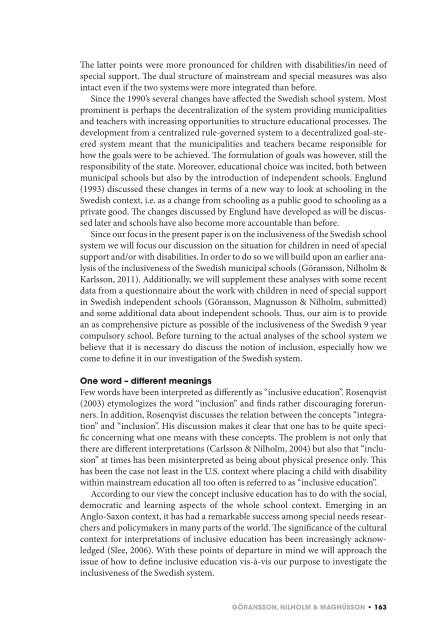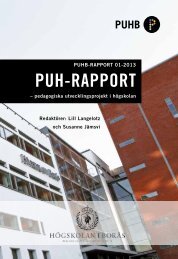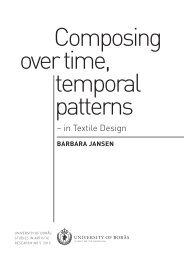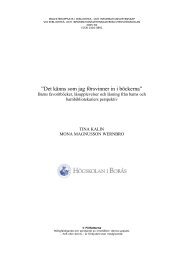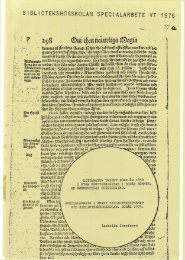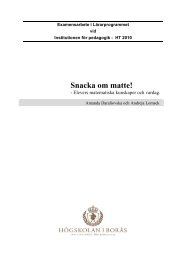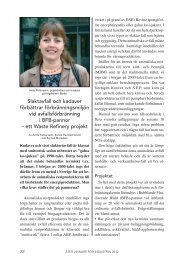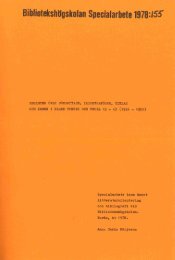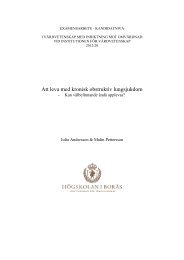Bildning för alla! - DiVA
Bildning för alla! - DiVA
Bildning för alla! - DiVA
Create successful ePaper yourself
Turn your PDF publications into a flip-book with our unique Google optimized e-Paper software.
The latter points were more pronounced for children with disabilities/in need of<br />
special support. The dual structure of mainstream and special measures was also<br />
intact even if the two systems were more integrated than before.<br />
Since the 1990’s several changes have affected the Swedish school system. Most<br />
prominent is perhaps the decentralization of the system providing municipalities<br />
and teachers with increasing opportunities to structure educational processes. The<br />
development from a centralized rule-governed system to a decentralized goal-steered<br />
system meant that the municipalities and teachers became responsible for<br />
how the goals were to be achieved. The formulation of goals was however, still the<br />
responsibility of the state. Moreover, educational choice was incited, both between<br />
municipal schools but also by the introduction of independent schools. Englund<br />
(1993) discussed these changes in terms of a new way to look at schooling in the<br />
Swedish context, i.e. as a change from schooling as a public good to schooling as a<br />
private good. The changes discussed by Englund have developed as will be discussed<br />
later and schools have also become more accountable than before.<br />
Since our focus in the present paper is on the inclusiveness of the Swedish school<br />
system we will focus our discussion on the situation for children in need of special<br />
support and/or with disabilities. In order to do so we will build upon an earlier analysis<br />
of the inclusiveness of the Swedish municipal schools (Göransson, Nilholm &<br />
Karlsson, 2011). Additionally, we will supplement these analyses with some recent<br />
data from a questionnaire about the work with children in need of special support<br />
in Swedish independent schools (Göransson, Magnusson & Nilholm, submitted)<br />
and some additional data about independent schools. Thus, our aim is to provide<br />
an as comprehensive picture as possible of the inclusiveness of the Swedish 9 year<br />
compulsory school. Before turning to the actual analyses of the school system we<br />
believe that it is necessary do discuss the notion of inclusion, especially how we<br />
come to define it in our investigation of the Swedish system.<br />
One word – different meanings<br />
Few words have been interpreted as differently as “inclusive education”. Rosenqvist<br />
(2003) etymologizes the word “inclusion” and finds rather discouraging forerunners.<br />
In addition, Rosenqvist discusses the relation between the concepts “integration”<br />
and “inclusion”. His discussion makes it clear that one has to be quite specific<br />
concerning what one means with these concepts. The problem is not only that<br />
there are different interpretations (Carlsson & Nilholm, 2004) but also that “inclusion”<br />
at times has been misinterpreted as being about physical presence only. This<br />
has been the case not least in the U.S. context where placing a child with disability<br />
within mainstream education all too often is referred to as “inclusive education”.<br />
According to our view the concept inclusive education has to do with the social,<br />
democratic and learning aspects of the whole school context. Emerging in an<br />
Anglo-Saxon context, it has had a remarkable success among special needs researchers<br />
and policymakers in many parts of the world. The significance of the cultural<br />
context for interpretations of inclusive education has been increasingly acknowledged<br />
(Slee, 2006). With these points of departure in mind we will approach the<br />
issue of how to define inclusive education vis-à-vis our purpose to investigate the<br />
inclusiveness of the Swedish system.<br />
gÖrAnSSOn, nilhOlM & MAgnÚSSOn • 163


